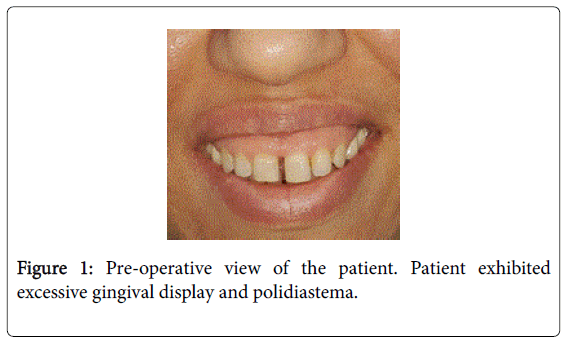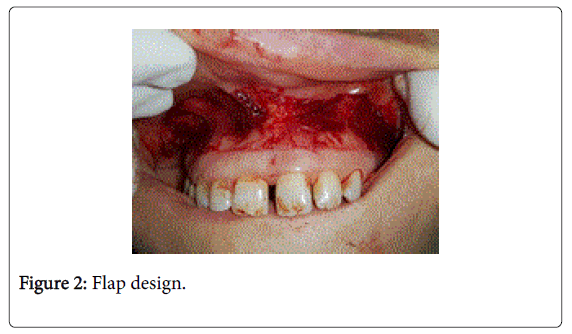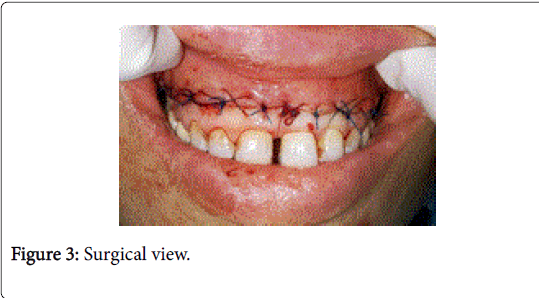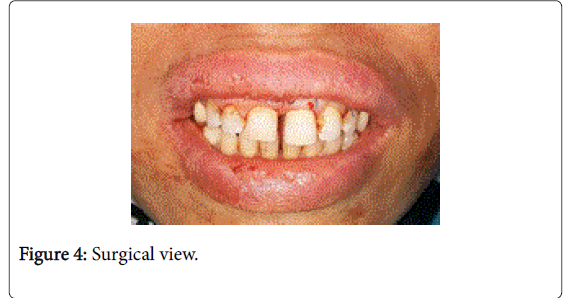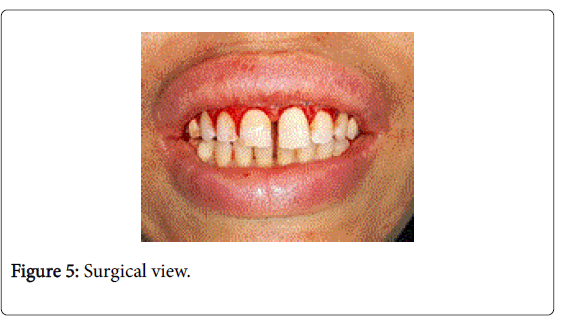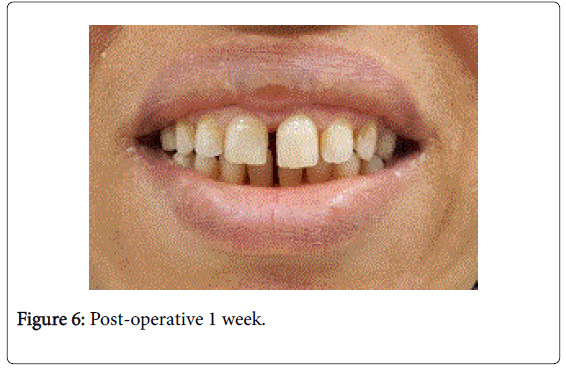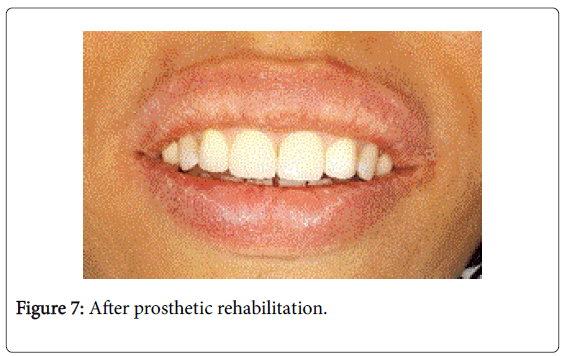Treatment of a Gummy Smile Case with Reverse Vestibuloplasty
Received: 26-Jun-2017 / Accepted Date: 28-Jun-2017 / Published Date: 05-Jul-2017 DOI: 10.4172/2161-119X.1000313
Abstract
Gingival display greater than 3 mm results in a situation termed as gummy smile and this situation is often esthetically unacceptable for the individual. Different techniques have been used in case of hiperactive upper lip: botulinum toxin injections, lip elongations with rhinoplasties, lip muscle detachments, myotomies and lip repositionings. We aimed to a present a case of a female patient with excesssive gingival display treated using reverse vestibuloplasty. 47 year old female patient came to our periodontology clinics complaining of an unesthetic excessive gingival display more than 10 mm. A treatment model combining of crown lenghtening procedures, reverse vestibuloplasty and esthetic prosthetic rehabilitation was planned. After local anesthesia, a horizontal incision from right upper molar to the left upper molar was made in the mucogingival juncion. A paralel horizontal incison was also made 10 mm coronally and two vertical incisions were made in the most distal parts of the flap design. Half-thickness flap was reflected and tissue was removed. Two horizontal incision lines were connected using simple suttures, so the upper lip was not excessively mobile any longer. Crown-lenghtening procedures were also performed. After one week, suttures were removed. Healing was uneventful. About a month later, esthetic prosthetic rehabilitation was performed. High-level patient satisfaction was achieved. Discussion: Different techniques could also be combined in the existence of gummy smile. Conclusion/clinical significance: Reverse vestibuloplasty is a minimal invasive surgical procedure with satisfying esthetic results as an alternative to orthognatic surgery.
Keywords: Excessive gingival display; Gummy smile; Reverse vestibuloplasty
255389Introduction
Facial esthetic is largely dependent on an esthetic and pleasing smile [1]. A harmonic and symmetric composition of the teeth, visible gingiva, buccal corridors and lips are requiered for the esthetic perception principles [2]. A smile line that displays the entire coronal portion of the teeth and some amount of gingival tissue (1-2 mm) is associated with youth. In contrast, a smile line with only a a portion of the coronal part of the teeth is associated with an older age [3,4]. It is also reported that the size of the teeth and upper lip position are the important factors for smile perception [4]. Excessive display of the gingival line-so called gummy smile- could be an important factor for an unesthetic smile [3]. A normal gingival display between the inferior border of the upper lip and the gingival margin of the central incisors during a normal smile is 1-2 mm. In contrast, an excessive gingival margin to the inferior border of the upper lip of a 3-4 mm or more is considered as unattractive [5].
Excessive gingival display affects approximately 10% of the population among 20-30 years old [6]. Females are more prone to have gummy smile. Gummy smile condition decreases with age due to the loss of muscle tone in both upper and lower lips [7]. Treatment methods for excessive gingival display are botulinum toxin injections, crown lenghtening procedures, orthognatic surgeries, intrusion and lip repositioning surgeries. Severe gummy smile cases and cases with multiple etiology could be treated with the combination of the listed techniques [8,9]. In case of severe increased vertical excess, orthognatic surgery is the optimum treatment method. However, it is an invasive technique which requieres hospitalization [10].
In our case report, we aimed to present a patient with an excessive vertical display and multiple diastema treated with reverse vestibuloplasty technique combined esthetic prosthetic rehabilitation.
Case
47 year old female patient came to our periodontology clinics complaining of an unesthetic excessive gingival display more than 10 mm, assymmetry and diastema on upper incisors (Figure 1).
A treatment model combining of crown lenghtening procedures, reverse vestibuloplasty and esthetic prosthetic rehabilitation was planned.
After local anesthesia, a horizontal incision from right upper molar to the left upper molar was performed in the mucogingival junction using 15 scalpel blade. A paralel horizontal incison was also made 10 mm coronally and two vertical incisions were made in the most distal parts of the flap design. Half-thickness flap was reflected and tissue was removed (Figure 2).
Two horizontal incision lines were connected using simple suttures (4.0 propylene), so the upper lip was not excessively mobile any longer. Crown-lenghtening procedures were also performed (Gingivectomy) (Figures 3-5).
Periodontal packing was placed. Antibiotic (Alfoxil 500 mg, 3 × 1) and analgesic (Majezik 100 mg, 2 × 1) were prescribed. No antimicrobial mouthrinse was prescribed. Patient was told to have a soft diet. After one week, periodontal packing and suttures were removed. The wound region was rinsed using SF. Healing was uneventful (Figure 6).
About a month later, esthetic prosthetic rehabilitation was performed. Teeth preparation was performed using chamfer technique. High-level patient satisfaction was achieved (Figure 7).
Discussion
Excessive gingival display, also known as the ‘gummy smile’ condition results in an unesthetic appearance of the smile line [3]. Patients with gummy smile could benefit from different treatment alternatives; for example reverse vestibuloplasty (lip repositioning), botulinium toxin injections and orthognatic surgical interventions.
In this case, we treated a gummy smile patient using reverse vestibuloplasty technique. This procedure involves the retraction of the elevator muscles of the lip (zygomaticus minor, levator anguli, orbicularis oris and levator labii superioris) resulting in the decreased gingival display [11]. This approach has its own indications, advantages and disadvantages. It is relatively minimal invasive, relatively stable and easy for a patient’s acceptance. It is a short and easy surgical procedure that approximately lasts 30 min. It is cost effective,it does not require hospitalization and could be easily performed under local anesthesia.
Reverse vestibuloplasty should be performed carefully. During surgery, minor submucosal salivary glands should be taken into account and a possible damage should be avoided. Clinicians also should leave adequate width of attached gingiva during sutturing. Patients with severe skeletal deformities are ideally treated with orthognatic surgical approaches and these patients are contraindicated for reverse vestibuloplasty [9].
Some reverse vestibuloplasty cases are reported in the literature with a rare complication of paresthesia and transient paralysis [12]. But generally, reverse vestibuloplasty is a safe and simple procedure [9]. In the presented case, we did not observe any complication.
In this case, we have had stable results using this technique (6 months). But further studies are needed in order to evaluate the long term stability of the reverse vestibuloplasty technique.
References
- Van der Geld P, Oosterveld P, Schols J, Kuljpers-Jagtman AM (2011) Smile line assesment comparing quantitative measurment and visual estimation. Am J Orthod Dentofacial Orthop 139: 174-180.
- Lombardi RE (1973) The Principles of visual perception and their clinical application to denture esthetics. J Proshet Dent 29: 58-82.
- Zawawi KH, Malki GA, Al-Zahrani MS, Alkhiary YM (2013) Effect of lip position and gingival display on smile and esthetics as perceived by college students with different educational backgrounds. Clin Cosmet Investig Dent 5: 77-80.
- Sarver DM, Ackerman MB (2003) Dynamic smile visualization and quantification: Part 1. Evolution of the concept and dynamic records for smile capture. Am J Orthod Dentofacial Orthop 124: 4-12.
- Kokich VO Jr, Kiyak HA, Shapiro PA (1999) Comparing the perception of dentists and lay people to altered dental esthetics. J Esthet Dent 11: 311-324.
- Tjan AH, Miller GD, The JG (1984) Some esthetic factors in a smile. J Prosthet Dent 51: 24-28.
- Desai S, Upadhyay M, Nanda R (2009) Dynamic smile analysis: Changes with age. Am J Orthod Dentofacial Orthop 136: 310.
- Mantovani MB, Souza EC, Marson FC, Correa GO, Progiante PS, et al. (2016) Use of modified lip repositioning technique associated with esthetic crown lengthening for treatment of excessive gingival display: A case report of multiple etiologies. J Indican Soc Periodontol 20: 82-87.
- Jananni M, Sivaramakrishnan M, Libby TJ (2014) Surgical correction of excessive gingival display in class I vertical maxillary excess: Mucosal strip technique. J Nat Sci Biol Med 5: 494-498.
- Polo M (2008) Botulinum toxin type A (Botox) for the neuromuscular correction of excessive gingival display on smiling (gummy smile). Am J Orthod Dentofacial Orthop 133: 195-203.
- Litton C, Fournier P (1979) Simple surgical correction of the gummy smile. Plast Reconstr Surg 63: 372-373.
- Miskinyar SA (1979) A new method for correcting gummy smile. Plast Reconstr Surg 72: 397-400.
Citation: Sahin D, Çakir M, Gökçe HS (2017) Treatment of a Gummy Smile Case with Reverse Vestibuloplasty. Otolaryngol (Sunnyvale) 7:313. DOI: 10.4172/2161-119X.1000313
Copyright: © 2017 Şahin D, et al. This is an open-access article distributed under the terms of the Creative Commons Attribution License, which permits unrestricted use, distributionand reproduction in any medium, provided the original author and source are credited.
Share This Article
Recommended Journals
Open Access Journals
Article Tools
Article Usage
- Total views: 5310
- [From(publication date): 0-2017 - Apr 07, 2025]
- Breakdown by view type
- HTML page views: 4448
- PDF downloads: 862

